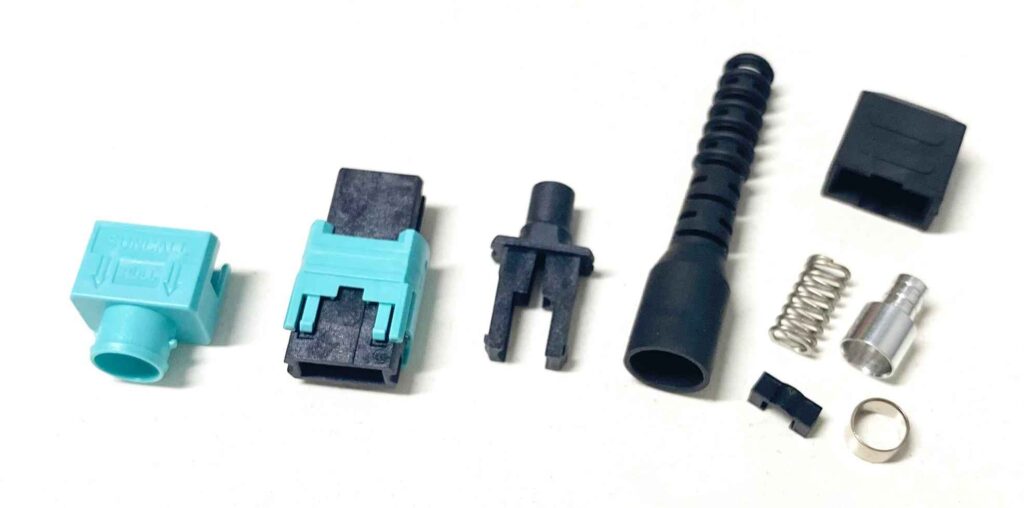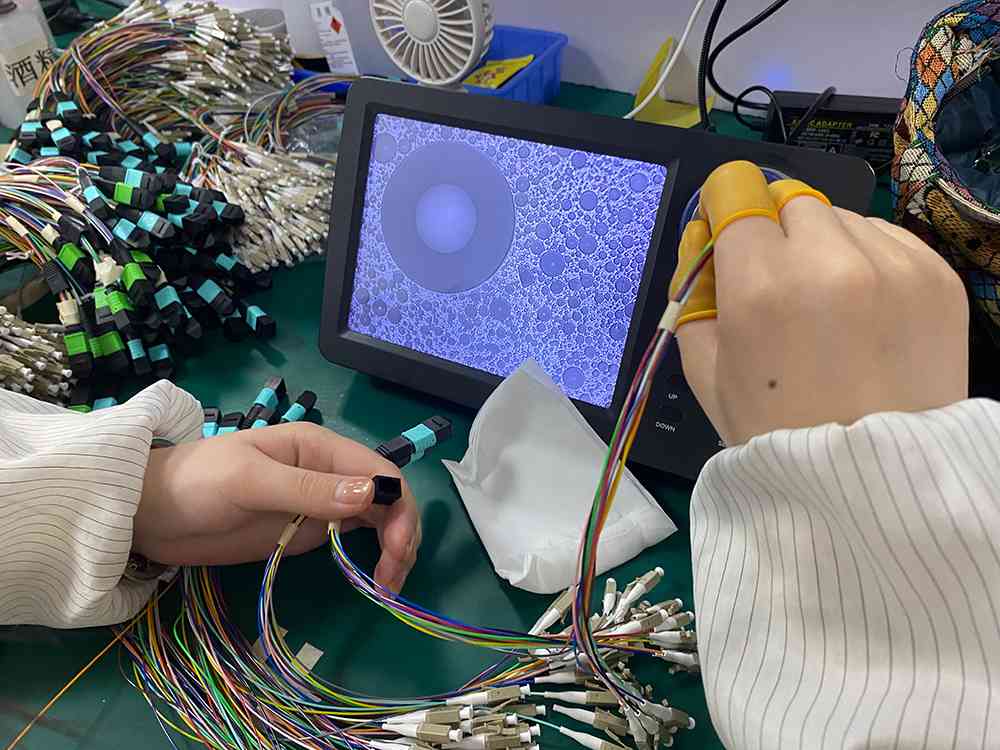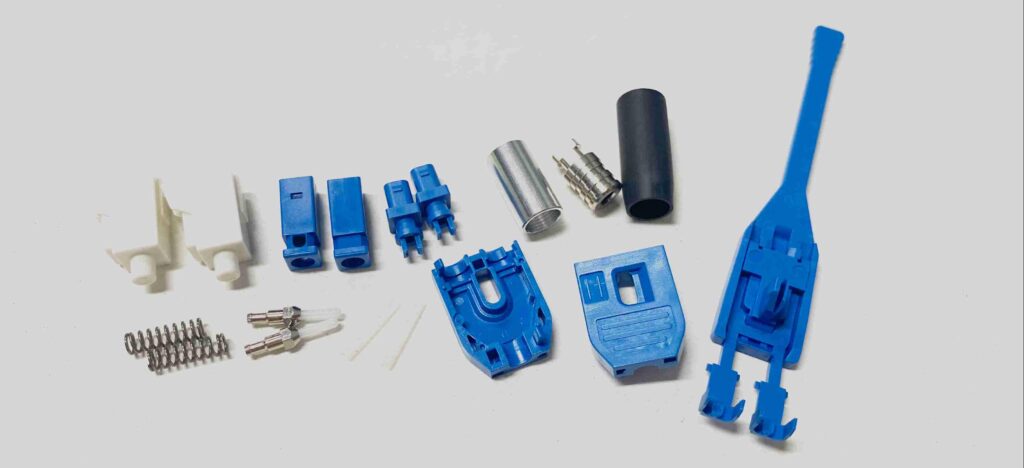Optical connector is fiber cable ends for FTTH or data center network, there are different fiber connector types like SC FC LC ST E2000 MTRJ MU MPO/MTP, etc, so how can we choose the connector that suits us?
In this article, we will systematically sort out the issues from interface compatibility, performance parameters to application scenario, hope it can help everyone.
1. Choose the right fiber optic connectors according to the the interface of the docked device.
| Equipment type | Recommended connectors | Core advantages |
| SFP/SFP+ module | LC | High-density layout (occupies 50% of SC connector) |
| GBIC module | SC | Plug-in buckle design, fast deployment |
| ODF patch panel | FC | Thread reinforcement to prevent loosening, carrier-grade reliability |
| 40G/100G switch | MPO/MTP | Support multi-fiber parallel transmission (12/24 cores) |
| Industrial control equipment | ST (metal reinforced) | Anti-vibration design, resistant to mechanical shock |
Note: Ordinary connectors are divided into male and female. The ports on general devices are female connectors, while the patch cords or pigtails that are inserted into the docking are male connectors.
MTP connectors need to distinguish between male (guide PINs) and female (guide hole) .Please refer to the article for more information: The difference, MPO male connector VS MPO female connector.

2. Select the end face and process according to performance requirements
For single fiber connectors, there are 3 types of End face grinding methods: UPC, APC and PC.
- APC (8°bevel): Return loss is≤-60dB, mandatory for CATV, DWDM system; green housing, preferred for broadcasting and television scenes.
- UPC (Ultra Physical Contact): Return loss is ≤-50dB, suitable for 10G, 25G Ethernet; blue housing connector, mainstream choice for data centers
- PC (Physical Contact): return loss is ≤-40dB, only used for low-speed short-distance transmission, like multimode OM1 OM2 OM3 OM4 OM5 connectors.

For multi core fiber connectors, like non-contact MPO, the connector is MT ferrule, not ceramic ferrule , it can avoids physical wear on the end face, and increases plug-in life by 3 times. This is widely used in high density applications like data center.
3. Customize the solution according to the deployment scenario
| Scenarios | Connector solution | Key indicators |
| High-density cabling in data centers | MPO pre-terminated + non-contact technology | Support ≤0.3dB insertion loss, dustproof IP68 |
| Industrial automation | ST + metal sleeve | Temperature resistance -40℃~105℃, anti-oil |
| FTTH access to homes | SC-APC (green) | Adaptive splitter, anti-reflection interference |
| In-vehicle networks | SMA-905 micro connector | Weight <5g, vibration tolerance 20G acceleration |
| Emergency repairs | Termination-free SC | Deployment can be completed in 30 seconds by hand |
Conclusion
So when we choose the fiber connectors, we should know the international standards of insertion loss and return loss, and CATV systems must use APC end faces, PC/UPC will cause signal reflection interference. Furthermore, when the cabinet is fully equipped, LC is preferred over SC to avoid overheating (LC power consumption is 40% lower). And for further compatibility or expand consideration, 50G PON needs to reserve APC connectors to support 32dB optical power budget, etc.
FAQ
- What are the advantages of optical connectors produced by China manufacturers?
First of all, the insertion loss of LC/SC connectors made in China is very stable and has reached the international mainstream. The price of LC connectors of the same specification is only 60% of that of international brands. MPO multi-core connectors support 144-core ultra-high-density wiring, adapt to the front panel interface requirements of NVIDIA CPO switches, reduce single-link power consumption by 30%, and the core component MT ferrule can be domestically mass-produced.

MPO/LC/SC connectors provided by YINGDA can replace 12 single fiber patch cords in the 800G optical module, save 70% wiring space. All conventional products have a certain inventory, fast delivery, customized grinding solutions.
2. How many types of end faces for connector optical?
Connector fiber end faces can be divided into PC (planar), UPC (hyper spherical), and APC (angled spherical). Different grinding methods affect the return loss performance.
3. What are the common types of fiber connectors?
There are several common types of fiber optic connectors:
- FC connector (Ferrule Connector) is fixed with metal threads, has good shockproof performance and high stability, and is commonly used in telecommunications base stations, long-distance single-mode transmission and test instruments.
- SC connector (Subscriber Connector) adopts a square plug-in design, with high installation density and small insertion loss fluctuation. It is mainly used in fiber to the home (FTTH), enterprise local area network (LAN) and data communication.
- LC connector (Lucent Connector) adopts a miniaturized design and a dual-core structure, which is suitable for high-density wiring, such as data centers, SFP/SFP+ optical modules and Gigabit/10G networks.
- ST connector (Straight Tip) adopts a circular snap-on connection, which is easy to install and low in cost. It is commonly used in early multi-mode networks (such as campus networks and monitoring systems).
- Multi-fiber connector MPO/MTP (Multi-fiber Termination Push-On) supports 12, 24, 48 ,72, 144 core parallel connr interconnections (DCI), CPO switches, and 400G/800G optical modules.
Other types such as E2000 connectors are equipped with dust covers and are highly secure, and are mainly used in high-demand environments such as European telecommunications networks.
4. What is lc duplex connector?
LC duplex connector is lc connector with 2 fibers inside, Yingda can provide many types of LC duplex connectors, with different boot, different press down kits, contact us for best price.
5. How to clean and maintain fiber optic connectors?
Cleaning and maintenance of patch cord connector is a key operation to ensure the quality of signal transmission. The production workshop is generally a dust-free workshop to prevent electrostatic damage and fingerprint contamination. Before or during production, our company will use dust-free paper (KIMTECH Wipes 34155) or alcohol cotton swabs for cleaning. After cleaning or when not in use, put on the dust cap in time. When in construction field, commonly used cleaning tools include dust-free cotton swabs, dust-free paper, one click cleaner pen or box cleaning box, etc.

